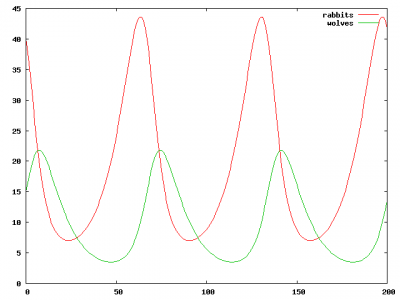I recall burning three or four weeks of a sabbatical getting Saccade.com on the air with Wordpress. So much tweaking…
Wolves And Rabbits
I really like programmpraxis.com. Today, they had an interesting little task, not so much for the program itself, but for what it reminded me of. But first, the task: basically to simulate a simple set of differential equations which model a predator prey relationship. It’s not that hard really, this just implements the model using a Runge-Kutta integrator.
Wolves And Rabbits « Programming Praxis.
#!/usr/bin/env python
# http://programmingpraxis.com/2009/12/01/wolves-and-rabbits/
def population(r, w, rg, wg, rd, wd):
def dr(x, y):
return rg * x - rd * x * y
def dw(x, y):
return wg * x * y - wd * x
while True:
yield r, w
rh = r + dr(r, w) / 2.
wh = w + dw(w, r) / 2.
r = r + dr(rh, wh)
w = w + dw(wh, rh)
g = population(40, 15, 0.1, 0.005, 0.01, 0.1)
for x in range(201):
r, w = g.next()
print r, w
If you plot out the data, you get curves looking like this:
This reminded me of an article by A. K. Dewdeny from Scientific American back in December of 1984, entitled Shark and fish wage an ecological war on the toroidal planet Wa-Tor. Wator was an implementation of a shark/fish predator prey model, but displays a similar set of interleaved periodic population changes. Unlike this program though, it works by directly simulating the world by creating individual sharks and fish, and modeling their interactions. It was a fun, simple project which didn’t require any real understanding of mathematical methods.

Comment from Phil
Time 12/2/2009 at 8:13 am
Glad you enjoy it. Perhaps you would like to post your code in the comments at Programming Praxis, so others can see it. Or a reference to your blog entry, if you prefer.
Could you please contact me by email, at your convenience. I have a question I would like to ask you off-line.
Phil